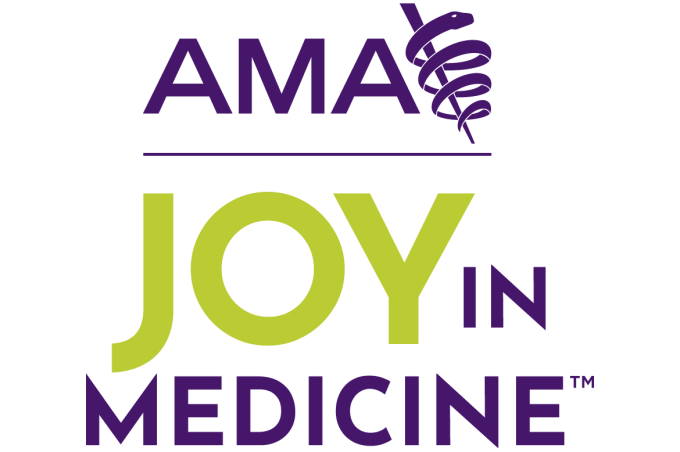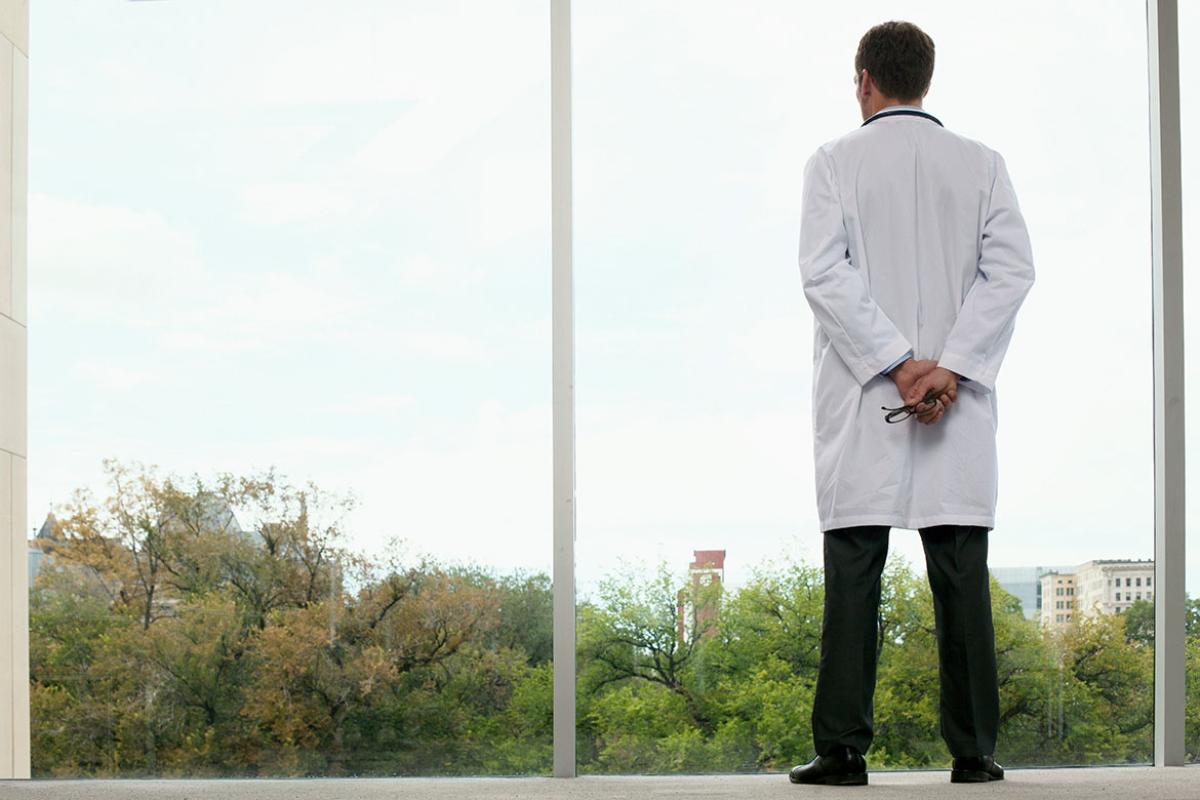Rush University Medical Center has built a reputation for fostering a culture of well-being and compassion.
But recent years have tested this approach, with the COVID-19 public health emergency and subsequent departure of qualified and experienced medical professionals from the field. The attrition has exacerbated longstanding contributing factors to physician burnout that far too often went unaddressed before the pandemic.
At a time when physician burnout and workforce shortages are pressing concerns, Rush’s ability to maintain and grow its team of exceptional doctors and other health professionals has become a model of resilience and innovation.
“We are driven by providing the highest quality care in the country with a focus on clinical excellence which is attractive to those considering joining the Rush team,” said Paul Casey, MD, senior vice president and system chief medical officer for Rush University System for Health, which is a member of the AMA Health System Program that provides enterprise solutions to equip leadership, physicians and care teams with resources to help drive the future of medicine.
“The most important thing that impacts one's decision to stay at an organization is the culture of the team, and our culture emphasizes wellness as much as it does excellence,” added Dr. Casey.
This reputation acts as a beacon, drawing physicians who want to be part of something meaningful toward Rush University System for Health.
While the recruitment team is actively searching across national and international landscapes, Dr. Casey acknowledges that “the most common and the strongest branding we have is the team that already works here at Rush.”
And while attracting physicians and other health professionals is vital, keeping them is arguably more important. Keeping communication open for feedback while also providing a broad array of well-being support has helped to sustain Rush’s culture.
“I see my job as a leader at Rush to be focused on creating those environments for our teams to be successful by being genuine, transparent, empathetic,” said Dr. Casey. “I strive to be an identifiable face where folks know they can reach out to me. People who come from other medical centers often make clear that the sense of community at Rush are very different from their past places of employment.”
Innovation-driven well-being
One of Rush’s more recent innovations is the creation of the Office of Provider Experience, an initiative to home in on what physicians need in an evolving health care landscape, to guide future supportive efforts.
Central to this improvement is reducing the administrative burden physicians face.
“We've embarked on this digital transformation looking at how can we lessen all the mundane tasks that clinicians too often get pulled into,” said Dr. Casey.
One key technological change was to offer ambient listening tools to physicians. The software transcribes conversations in real time, allowing physicians to “unhook from the keyboard and spend more meaningful time with patients,” said Dr. Casey.
Rush teams continue to assess how augmented intelligence (AI)—often referred to as artificial intelligence—technology can help meaningfully reduce administrative burdens, without sacrificing quality of care for patients.
Support career growth, mentorship
Mentorship is more than a tradition at Rush—it’s a pillar of its strategy. Weaving mentorship opportunities into the fabric of the institution is a deliberate effort to build strong career pathways, supported by nationally recognized leaders who are deeply invested in the success of their colleagues.
Specifically for medical students, “mentorship and faculty engagement provide guidance in medicine as a profession, career choices, specialties and personal relationships,” said Cynthia Boyd, MD, associate dean of admissions and recruitment at Rush Medical College. “Mentorship offers research opportunities, clinical experiences and leadership roles within the Rush system, leading to future collaborations and employment.”
“I've benefited from a number of mentors including my predecessor Dr. Omar Lateef, who's our system CEO now,” said Dr. Casey. “I am fortunate, having been working at Rush for 15 years, to be a mentor for others and to see the fruits of those exchanges, whether for people who stayed at Rush or went on to do great things elsewhere in healthcare.”
Rush’s educational incentives also offer meaningful opportunities for development. The institution provides access to advanced training, including a Master of Health Sciences program and the recently launched AI Learning Academy. The potential for professional growth across a wide array of disciplines, including those that are adjacent to health care, gives substance behind an environment that encourages overall well-being.
“A number of people also really want to think about their continued professional development when they are coming to an academic health system,” said Dr. Casey. “I am one of them. I earned an MBA during my time at Rush that allowed me to expand my horizons. I always encourage people to continue learning wherever their passion may drive them.”
Recognition, joy and recruitment
Rush’s inclusion in the AMA Joy in Medicine® Health System Recognition Program has become more than a badge of honor—it’s a recruitment tool and a reaffirmation of the institutions values.
“It's a credit to our teams to be so focused on wellness, and not just physical well-being, also mental well-being,” said Dr. Casey. “The recognition not only helps in recruitment, but also achieving this recognition helps us to sustains our efforts to continue to make Rush the best possible environment to practice medicine.”
Another way Rush fosters well-being is to be actively engaged in local communities.
“The Rush Community Service Initiatives Program (RCSIP) provides opportunities for Rush University students, faculty, residents, fellows and staff to apply their skills and talents within the community,” said Dr. Boyd. “RCSIP aims to offer community-based volunteer experiences that enhance teamwork, patient relationships and care for diverse populations, while addressing specific community needs.”
The program’s “activities align with the findings from the Rush community health needs assessment, focusing on access, health promotion and pipeline programs for health care careers,” she said, noting that “a study at Rush found that 66% of current students chose Rush because of RCSIP opportunities,” which have been available for more than 30 years.
With over 90% of Rush University students volunteering in the community, RCSIP offers a distinct pathway for Rush staff and students to connect with Chicago’s West Side.
Work-life balance by design
Rush’s commitment to well-being is built into the infrastructure. A wellness center provides 24/7 access for staff needs, run by a team that actively rounds and is visible and present in the Rush environment. Virtual care options continue to be expanded to support flexibility.
These resources proved especially crucial during the COVID-19 public health emergency and remain essential today.
“We've tried to be very agile and adapt to the environment and really listen about what folks need when it comes to work-life balance,” said Dr. Casey. “We want to be thoughtful running the health system well, and make it the best possible environment, while providing people the best possible balance in their lives.”
Responding to recruitment challenges
Nationwide, the health care sector is grappling with shortages, but Rush’s proactive strategy has helped it weather the storm while maintaining their well-being efforts.
“We will likely continue operating in a challenging health care environment,” said Dr. Casey. “If we are maintaining wellness and that sense of community, it will ease the problems to a degree. There are times where we will be pressed and strained, but we have been really agile and responsive to changing needs with a relentless focus on our mission and our patients.”
For example, “we look at things like competitive pay and benefits,” he added. But the real work happens on the ground—connecting with teams to identify roadblocks and responding swiftly.
Maintaining equity and inclusion
Rush University Medical Center, the largest hospital of the system, is within Chicago’s West Side, and has long been active and involved in the neighboring communities to make an impact outside of the hospital walls.
“We’re always trying to make sure that we're inclusive in our workforce to really reflect the patients we serve,” said Dr. Casey.
That commitment supports a larger mission of health equity through partnerships such as West Side United.
“The medical center sits in a socioeconomically challenged area, so our ability to truly impact health outcomes and elevate the health of those we're serving is a big point of pride for staff,” Dr. Casey said.
Learn about the AMA's 2024-2025 strategic plan to advance health equity, and read a Leadership Viewpoints column detailing how the AMA is reaffirming its commitment to health equity.
Physician-led—and proud of it
Rush leaders make themselves visible and available to staff in ways that aren’t common. The accessibility and engagement help physicians feel supported.
“There is a great deal of pride in and a benefit of Rush being a physician-led organization,” said Dr. Casey. “I've had a number of folks come in from other hospitals and they say that they never would've had a chance to sit down with a chief medical officer at their past medical centers.”
Dr. Casey himself is involved in the recruitment process, estimating that he has interviewed thousands of candidates. Having the chance to speak with heads of the system during interviews also helps to acquaint candidates with Rush’s style and environment.
“Candidates are often assured when they see leadership taking such an active interest in recruiting,” Dr. Casey said. “They see that commitment and they feel that.”
Expand talent, maintain culture
Regarding recruitment, Rush looks to expand its deep bench of talent, while maintaining their culture. Teams aim to continue reaching more people who may not be familiar with Rush’s facets and commitment to excellence.
“We have some aggressive plans in terms of our physical locations, but also our digital presence,” said Dr. Casey.
Ultimately, Rush’s “secret sauce,” as Dr. Casey calls it, is its culture—a blend of clinical excellence, compassion and community.
“The sense of community and the culture that we've built and the focus on clinical excellence above all else, and just providing exemplary patient care every single day. They all are incredibly meaningful to us here,” he said.






